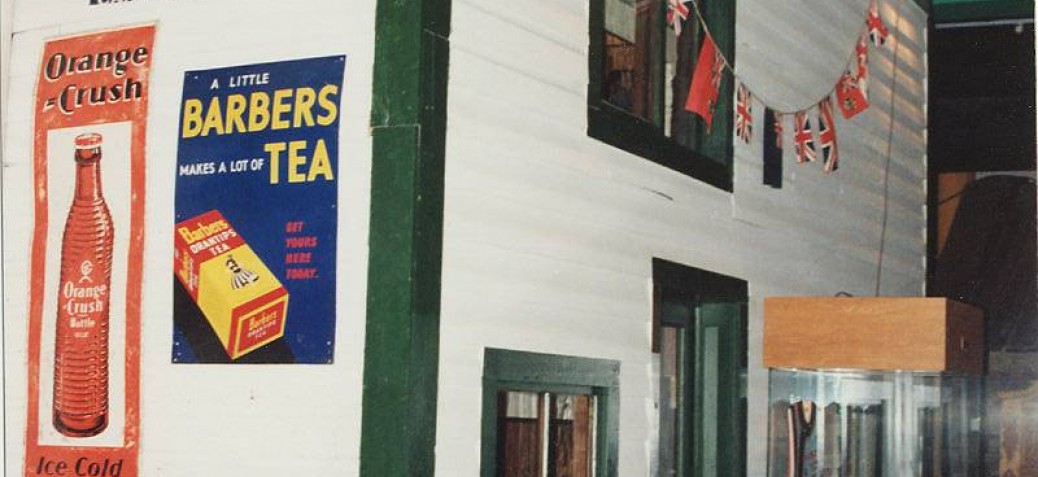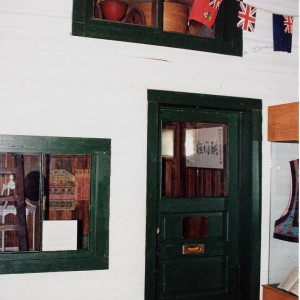Chinese Store (Kelowna Museum, 470 Queensway)
Place Description
The historic place is a portion of the facade of the reconstructed wood Chinese Store, probably built in the early 1920s at 245 Harvey Avenue, as part of Kelowna's former 'Chinatown', and now located in the Kelowna Museum at 470 Queensway Avenue.
Heritage Value
The Chinese Store, now reconstructed in the Kelowna Museum, is a significant heritage resource valued for its representation as a reminder of the lives and customs of Kelowna's once thriving, self-contained Chinese community. In the early twentieth century the population of the Chinese community numbered about five hundred, or some 10% of the entire local population. The historic place also has value for its close association with several important members of Kelowna's Chinese community.
The building has value as a rare, or perhaps unique, surviving fragment of Kelowna's former Chinatown. It originally stood on the south side of Eli (now 245 Harvey) Avenue. It was the home of Wong Bat (born c. 1885), manager of the Kon Wo Company grocery next door. It was probably built in the early 1920s, as the Kon Wo Company first appears in the 1922 B.C. Directory. However, if Wong Bat took over an existing building it could be considerably older, as local historian Frank Buckland mentions 'one or two Chinese houses and a store' on the west end of the south side of Eli Avenue in the 1890s. In 1928 an addition of 'sleeping accommodation' was made.
Wong Bat was an important player within the Chinese community. He prospered, and by 1930 he owned two properties and buildings valued at $4,100, plus a share in another. He was described as "a clever business man", being among other things a large-scale onion buyer and a shareholder in the Golden Pheasant Cafe. When the Great Depression came, he was prominent in efforts to raise relief funds for destitute Chinese.
About 1930 Wong Bat wed, in an arranged marriage, Sue Lee Ping from Vancouver. She, too, has heritage value for her life and associations. Born in 1911, she had been brought from China at the age of seven as a bonded servant to the many children of Yip Wing Sang, a wealthy Chinese businessman in Vancouver, who was a significant member of that City's Chinese community. The couple had two daughters.
Wong Bat was murdered on December 1, 1932, as he returned home from his store. The killer was a Japanese immigrant, M. Hamasaki, who was unable to find work in the hard times of the Depression and was destitute. The motive was the large roll of cash, $500 or $600, which Wong Bat customarily carried on his person.
Although Wong Bat left a substantial estate, Sue Lee Ping had no understanding of his business and did not speak English. Her assets were lost to unscrupulous individuals. The Kon Wo Company store closed in 1934, and eventually the properties on the south side of Harvey Avenue were lost for non-payment of taxes. She did manage to save the house itself, which in 1937 she had moved to 245 Leon Avenue, a lot she had bought for $100. A small addition was put onto the back of the house.
While remarriage of widows was strongly discouraged by Chinese traditions, Sue Lee Ping's difficulties overweighed custom. In 1937 she married Wong Ying, who had come to Canada in 1919 and arrived in Kelowna the year before, working for the Ritchie Orchard in the Glenmore area of Kelowna. Over the next fourteen years they had nine children, all of whom Wong Ying himself delivered because they could not afford the hospital facilities.
After Wong Ying died in 1960, Sue Lee Wong supported her family by making and selling tofu (soy bean curd) to the Chinese and Japanese communities. The grindstone she used is in the Kelowna Museum. She insisted on her children completing their schooling. One of them, Tun Wong, was for many years deputy treasurer of the City of Kelowna and still resides in the community.
Mrs. Wong lived in the house until 1970, when she moved to be nearer her son. The building was sold a year later, and in 1973 it was torn down to make way for a parking lot.
Character Defining Elements
- Salvaged and relocated heritage building in prominent location in the Kelowna Museum
- Form, scale, and massing expressed by 2-storey false-front facade and shallow-depth display on the interior
- Horizontal beveled wood siding, with vertical wood corner trim
- Wood-sash windows with wood trim
- Panelled wood door with fixed-pane window





